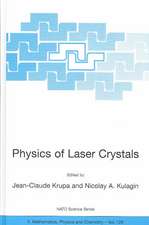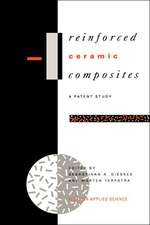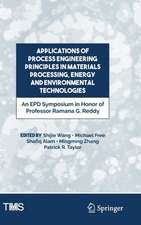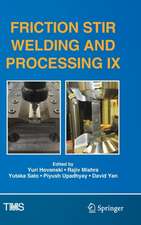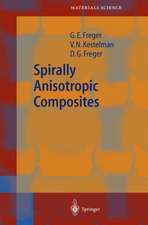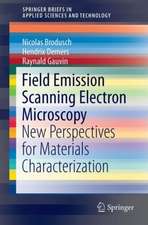IUTAM Symposium on Modelling Nanomaterials and Nanosystems: Proceedings of the IUTAM Symposium held in Aalborg, Denmark, 19-22 May, 2008: IUTAM Bookseries, cartea 13
Editat de R. Pyrz, Jens C. Rauheen Limba Engleză Hardback – 3 dec 2008
| Toate formatele și edițiile | Preț | Express |
|---|---|---|
| Paperback (1) | 947.18 lei 6-8 săpt. | |
| SPRINGER NETHERLANDS – 28 oct 2010 | 947.18 lei 6-8 săpt. | |
| Hardback (1) | 955.25 lei 6-8 săpt. | |
| SPRINGER NETHERLANDS – 3 dec 2008 | 955.25 lei 6-8 săpt. |
Din seria IUTAM Bookseries
- 18%
 Preț: 952.09 lei
Preț: 952.09 lei - 18%
 Preț: 956.99 lei
Preț: 956.99 lei - 15%
 Preț: 648.05 lei
Preț: 648.05 lei - 18%
 Preț: 958.38 lei
Preț: 958.38 lei - 15%
 Preț: 643.84 lei
Preț: 643.84 lei - 15%
 Preț: 656.25 lei
Preț: 656.25 lei - 15%
 Preț: 637.28 lei
Preț: 637.28 lei - 15%
 Preț: 640.37 lei
Preț: 640.37 lei - 15%
 Preț: 639.73 lei
Preț: 639.73 lei - 18%
 Preț: 1826.34 lei
Preț: 1826.34 lei - 18%
 Preț: 948.29 lei
Preț: 948.29 lei - 15%
 Preț: 656.43 lei
Preț: 656.43 lei - 18%
 Preț: 967.88 lei
Preț: 967.88 lei - 18%
 Preț: 944.36 lei
Preț: 944.36 lei - 20%
 Preț: 552.13 lei
Preț: 552.13 lei - 24%
 Preț: 1576.18 lei
Preț: 1576.18 lei - 18%
 Preț: 945.62 lei
Preț: 945.62 lei - 18%
 Preț: 1230.35 lei
Preț: 1230.35 lei - 24%
 Preț: 798.22 lei
Preț: 798.22 lei - 24%
 Preț: 799.81 lei
Preț: 799.81 lei - 18%
 Preț: 945.79 lei
Preț: 945.79 lei - 15%
 Preț: 642.83 lei
Preț: 642.83 lei - 18%
 Preț: 950.84 lei
Preț: 950.84 lei - 15%
 Preț: 641.85 lei
Preț: 641.85 lei - 18%
 Preț: 945.79 lei
Preț: 945.79 lei
Preț: 955.25 lei
Preț vechi: 1164.93 lei
-18% Nou
Puncte Express: 1433
Preț estimativ în valută:
182.81€ • 198.50$ • 153.56£
182.81€ • 198.50$ • 153.56£
Carte tipărită la comandă
Livrare economică 22 aprilie-06 mai
Preluare comenzi: 021 569.72.76
Specificații
ISBN-13: 9781402095566
ISBN-10: 1402095562
Pagini: 352
Ilustrații: X, 342 p.
Dimensiuni: 155 x 235 x 23 mm
Greutate: 0.73 kg
Ediția:2009
Editura: SPRINGER NETHERLANDS
Colecția Springer
Seria IUTAM Bookseries
Locul publicării:Dordrecht, Netherlands
ISBN-10: 1402095562
Pagini: 352
Ilustrații: X, 342 p.
Dimensiuni: 155 x 235 x 23 mm
Greutate: 0.73 kg
Ediția:2009
Editura: SPRINGER NETHERLANDS
Colecția Springer
Seria IUTAM Bookseries
Locul publicării:Dordrecht, Netherlands
Public țintă
ResearchCuprins
Multiscale Failure Modeling: From Atomic Bonds to Hyperelasticity with Softening.- Crack Initiation, Kinking and Nanoscale Damage in Silica Glass: Multimillion-Atom Molecular Dynamics Simulations.- Multiscale Modelling of Layered-Silicate/PET Nanocomposites during Solid-State Processing.- Modelling Transient Heat Conduction at Multiple Length and Time Scales: A Coupled Non-Equilibrium Molecular Dynamics/Continuum Approach.- Multiscale Modeling of Amorphous Materials with Adaptivity.- Thermodynamically-Consistent Multiscale Constitutive Modeling of Glassy Polymer Materials.- Effective Wall Thickness of Single-Walled Carbon Nanotubes for Multi-Scale Analysis: The Problem and a Possible Solution.- Discrete-Continuum Transition in Modelling Nanomaterials.- Looking beyond Limitations of Diffraction Methods of Structural Analysis of Nanocrystalline Materials.- Multiscale Modelling of Mechanical Anisotropy of Metals.- Micromechanical Modeling of the Elastic Behavior of Multilayer Thin Films; Comparison with In Situ Data from X-Ray Diffraction.- Two Minimisation Approximations for Joining Carbon Nanostructures.- On the Eigenfrequencies of an Ordered System of Nanoobjects.- Monitoring of Molecule Adsorption and Stress Evolutions by In-situ Microcantilever Systems.- Using Thermal Gradients for Actuation in the Nanoscale.- Systematic Design of Metamaterials by Topology Optimization.- Modeling of Indentation Damage in Single and Multilayer Coatings.- Reverse Hall–Petch Effect in Ultra Nanocrystalline Diamond.- Elastic Fields in Quantum Dot Structures with Arbitrary Shapes and Interface Effects.- Numerical Modelling of Nano Inclusions in Small and Large Deformations Using a Level-Set/Extended Finite Element Method.- Thermo-Elastic Size-Dependent Properties of Nano-Composites withImperfect Interfaces.- Modeling the Stress Transfer between Carbon Nanotubes and a Polymer Matrix during Cyclic Deformation.- Atomistic Studies of the Elastic Properties of Metallic BCC Nanowires and Films.- Advanced Continuum-Atomistic Model of Materials Based on Coupled Boundary Element and Molecular Approaches.- Finite Element Modelling Clay Nanocomposites and Interface Effects on Mechanical Properties.- Small Scale and/or High Resolution Elasticity.- Multiscale Molecular Modelling of Dispersion of Nanoparticles in Polymer Systems of Industrial Interest.- Structural-Scaling Transitions in Mesodefect Ensembles and Properties of Bulk Nanostructural Materials Modeling and Experimental Study.- Modeling Electrospinning of Nanofibers.- Use of Reptation Dynamics in Modelling Molecular Interphase in Polymer Nano-Composite.
Textul de pe ultima copertă
Recent interest in nanotechnology is challenging the community to analyse, develop and design nanometer to micrometer-sized devices for applications in new generations of computer, electronics, photonics and drug delivery systems. To successfully design and fabricate novel nanomaterials and nanosystems, we must necessarily bridge the gap in our understanding of mechanical properties and processes at length scales ranging from 100 nanometers (where atomistic simulations are currently possible) to a micron (where continuum mechanics is experimentally validated). For this purpose the difficulties and complexity originate in the substantial differences in philosophy and viewpoints between conventional continuum mechanics and quantum theories. The challenge lies in how to establish the relationship between a continuum mechanical system and its atomistic counterpart in order to define continuum variables that are calculable within an atomic system.
A major focus of the symposium is on modelling schemes, which allow for concurrent atomistic and continuum description of deformation and fracture of advanced materials. Contributions cover development and implementation of models and theories, which account for the full transition from an atomistic description to a continuum description, and vice versa, in a seamless manner. Particular attention is devoted to two approaches, namely, simultaneous (synchronous, direct) integration methods, where interacting simulation and modelling levels are simultaneously considered, and sequential (non-synchronous, indirect) integration methods, which consist of an appropriate transfer of parameters among calculations that are used sequentially. The distinction is made between methods which are discrete both at the atomic and continuum level and methods which embed statistics of the atomic level in the continuum level.
A major focus of the symposium is on modelling schemes, which allow for concurrent atomistic and continuum description of deformation and fracture of advanced materials. Contributions cover development and implementation of models and theories, which account for the full transition from an atomistic description to a continuum description, and vice versa, in a seamless manner. Particular attention is devoted to two approaches, namely, simultaneous (synchronous, direct) integration methods, where interacting simulation and modelling levels are simultaneously considered, and sequential (non-synchronous, indirect) integration methods, which consist of an appropriate transfer of parameters among calculations that are used sequentially. The distinction is made between methods which are discrete both at the atomic and continuum level and methods which embed statistics of the atomic level in the continuum level.
Caracteristici
State-of-the-art contributions in the field of modeling nanomaterials


